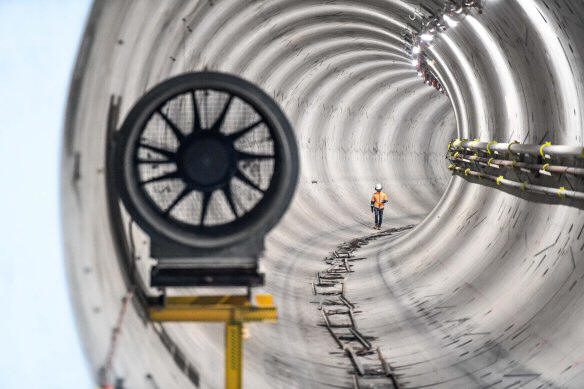State debts growing faster than federal as infrastructure pipeline extends - SMH - Shane Wright and Rachel Clun February 27, 2023
Australia’s states and territories are on track to have $600 billion in debt by next year as they continue to ramp up spending on politically attractive infrastructure projects and struggle to contain the cost of work already in the pipeline.
Analysis released on Monday by ratings agency S&P Global shows the states and territories, led by Victoria and NSW, had a record $500 billion in combined debt late last year and will add another $100 billion within 24 months.

Many states and territories are putting their surprise revenues into more infrastructure spending.
Federal government gross debt sits at $897 billion, although that is forecast to grow, in part due to plans for the National Reconstruction Fund ($15 billion) and the Housing Australia Future Fund ($10 billion).
But the combined debt of the states and territories is now growing faster than the federal government’s debt load.
S&P credit analyst Martin Foo said the states and territories were likely to borrow between $50 billion and $55 billion a year over the next few years.
Martin Foo says the days of “budget repair discipline” are ending.
The days of “budget repair
discipline” are ending, Foo said, as many recycled surprise revenues into more
spending.
Cumulatively, the states and territories have budgeted to spend $319 billion on infrastructure between 2023 and 2026. That is 37 per cent up on the previous four years and about the same amount the federal government spent on dealing with the COVID-19 pandemic.
S&P said an element of the spending was being driven by elections, noting Victorians went to the polls late last year while NSW voters will cast their ballots next month.
“Infrastructure spending is politically attractive. Elected officials get to announce projects they say will bust congestion and shorten commuting times,” the agency said.
Victoria and NSW are on track to hold about $220 billion in debt each by 2026. This year, Victoria is expected to hold about $170 billion in debt while NSW is forecast to hold about $160 billion.
Foo said the states routinely under-delivered on their infrastructure plans. In 2022, they underspent 14 per cent of what they had expected to outlay on their various projects.
“Projects invariably stall because of shortages of raw materials and skilled labour, complicated planning rules, legal or contractual disputes, and unforeseen environmental conditions,” he said.
“We expect these conditions to persist, meaning shallower but more prolonged growth in public debt than what states forecast.”
Tasmania is at a real risk of not meeting its forecasts. Its infrastructure plans for the next four years equate to 25.5 per cent of the Tasmanian economy compared to Western Australia which expects to spend the equivalent of 8.6 per cent of its economy.
Planning Woolloongabba to become city’s second CBD under new stadium deal
Foo said the surge in the cost of building projects had been expected to force states and territories to wind back their plans.
Instead, spending has been pushed out further into infrastructure timelines.
“So far, though, only a small handful of tunnel, rail, and stadium plans have been scrapped,” he said.
“Many instead have been rescheduled, as states recalibrate to an overstretched construction industry.”
Even beyond 2026, the states and territories have grand plans.
The Victorian government’s Suburban Rail Loop is budgeted at up to $34.5 billion by 2035 while the Queensland government recently revealed the upgrade of the Gabba for the Brisbane Olympics in 2032 had more than doubled in forecast cost.
Foo said while the states and territories were spending revenue windfalls on more projects, the federal government had actually largely banked all its extra cash as it was wary of inflation pressures.

